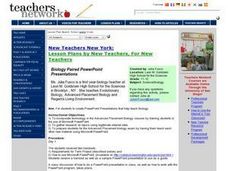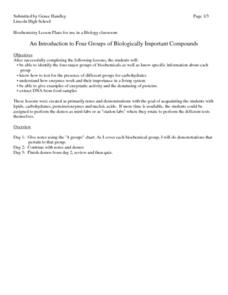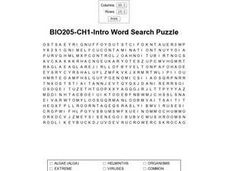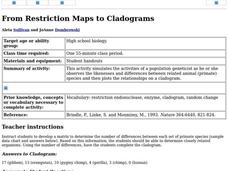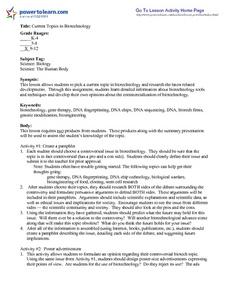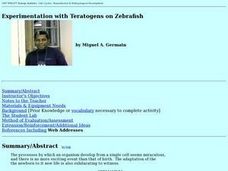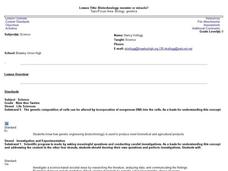Curated OER
Genetically-Modified Food
Students investigate the pros and cons of genetic engineering. They watch a short Bill Moyers video, conduct Internet research, create a poster, participate in a pro/con debate, and write an essay expressing their personal feelings on...
Curated OER
Embryology as Evidence of Evolution
Students observe the two major developmental pathways (protostome and deuterostome). They analyze data regarding differences in nucleotide sequences and construct a phylogenetic tree. They observe the similar evolutionary history shared...
Curated OER
Using Concept Maps to Teach Evolution
Students encounter concept maps for reviewing evolution. Concept maps provides an alternative method of interacting with the information and a forum for asking questions about vocabulary, concepts and interrelationships. A quiz is...
Curated OER
Pets: Oh Behave
Students develop an understanding of how innate and learned behaviors and the environment determine behavior. They see how a variety of factors affects our pet's behavior-including species-specific traits, the environment, training, and...
Curated OER
Biology Paired PowerPoint Presentations
Students incorporate technology by creating a Microsoft PowerPoint. Students experiment with various animation techniques and slide formats, so that they become familiar with the program. They gather research information on topics using...
Curated OER
An Introduction to Four Groups of Biologically Important Compounds
High schoolers learn about the four biochemicals that are important biologically. In this biochemicals lesson plan, students identify the four major groups of biochemicals including carbohydrates, proteins, lipids and nucleic acids. They...
Curated OER
The Euglena and Spirogyra
In this Euglena and Spirogyra worksheet, students read about these two Protozoans and they answer fourteen questions about their specified structures and functions. They color a diagram of Euglena and Spirogyra and label their parts.
Curated OER
The Death Penalty
Students examine the controversy surrounding the death penalty. In this capital punishment lesson, students explore the ethical concerns and religious beliefs regarding the death penalty. Students conduct research, interview people, and...
Curated OER
The Death Penalty
Young scholars examine the controversy surrounding the death penalty in the United States. For this current events lesson, students research the history of the death penalty as well perspectives on the topic. Young scholars interview...
Curated OER
Cell Cycle, Mitosis and Meiosis
Seventh graders describe the processes involved in mitosis and meiosis. In this life science lesson, 7th graders create chromosome models using strings and beads. They play a jeopardy team game at the end of the unit to review concepts...
Curated OER
Born of Blood: Inheritance of Blood Types
Pupils examine inheritance of blood types. In the chromosome lesson, students create a model of chromosome and predict the blood type of offspring.
Curated OER
PROTOPLAST PRODUCTION
Students are allowed to strip away the cell walls of plants cells (using enzymes) and then observe the resulting spherical protoplasts (plant cells minus the cell wall). They see that plants cells indeed have a plasma membrane in...
Curated OER
BIO205-CH1- Intro Word Search
In this word search worksheet, students locate words related to biology. The word list includes protists, viruses, plants, spiral, and biotechnology.
Curated OER
From Restriction Maps to Cladograms
Students develop a matrix to determine the number of differences between each set of primate species. They determine closely related organisms then complete the cladogram and answer a set of questions.
Curated OER
Current Topics in Biotechnology
Eleventh graders are introduced to the concept of biotechnology. Using the internet, they research the latest developments in this field and the tools used by biotechnologists. They share their information with the class and create a...
Curated OER
Time Conceptualization
Students relate the number and length of generations in their living family members to the number of generations that have passed since specific events in recorded history. They then apply this time conceptualization to the number of...
Curated OER
Construction of a Hemoglobin Gene
Students see how eight pairs of triplets are equivalent to part of a gene and control a part of heredity. They comprehend how blood corpuscles manufacture normal hemoglobin. Students already comprehend that genes control the synthesis...
Curated OER
Cells Study Questions and Definition
In this cells worksheet, pupils define 14 words associated with cells. They answer 12 short answer questions about the structure and function of the cellular system.
Curated OER
All Aboard for Protein Synthesis
Fourth graders walk through the process of transcription and translation to demonstrate and explain protein synthesis. They utilize a worksheet imbedded in this plan to guide their role play.
Curated OER
Teaching Biotechnology With Models
Learners will construct models to obtain understanding about the scientific concept. The kinesthetic learners will benefit from the project. There is ample opportunity for all types of learners to be engaged in this lesson.
Curated OER
Birds of a Feather Flock to the Web
Students define the term "evolution" and relate it to species adaptation, supporting their ideas with examples. They locate, correctly cite, and briefly review two Web sites with information on finches commonly found in their state or count
Curated OER
Experimentation with Teratogens on Zebrafish
Pupils compare mitosis and meiosis with regard to chromosome number in parent cells versus daughter cells, types of cells produced, total number of cells produced, and the number of divisions. In groups, identify and differentiate the...
Curated OER
Protein Synthesis and Words
Students explain the roles of mRNA, tRNA and ribosomes. They explain how mutations can occur in an individual. Students simulate parts of a cell to access about the process of protein synthesis.
Curated OER
Biotechnology: Monster or Miracle
Students explore biotechnology. In this scenario-based lesson, students take a survey on what they know about genetic engineering, view a PowerPoint, and conduct a web quest. Students will then be placed in groups, and produce one of the...




